Abstract
The effect, therapeutic dose range, and pharmacokinetics of apomorphine, given as subcutaneous injections by a single use pen, were evaluated in the treatment of off phenomena in 22 patients with idiopathic Parkinson's disease. At study entry a placebo controlled apomorphine test was performed, and apomorphine doses were then individually titrated (mean 3.4 (range 0.8-6.0) mg) and compared with placebo in a double blind cross over phase. With apomorphine compared with placebo the mean daily duration of off periods was reduced by 51% as assessed by the patients and by 58% as assessed by the staff. The severity of off periods was also significantly reduced. The effect was unchanged after a maintenance phase of eight weeks. At study termination 13 of 14 patients were able to inject themselves and 11 of 14 patients found that their feeling of freedom had increased. The most common adverse events were nausea, subcutaneous nodules, and increased frequency of involuntary movements. Pharmacokinetics were linear and did not change with repeat dosing. The tmax ranged from five to 45 minutes (16 patients). It is concluded that pen injected apomorphine is a valuable treatment for patients with advanced Parkinson's disease with on-off phenomena.
Full text
PDF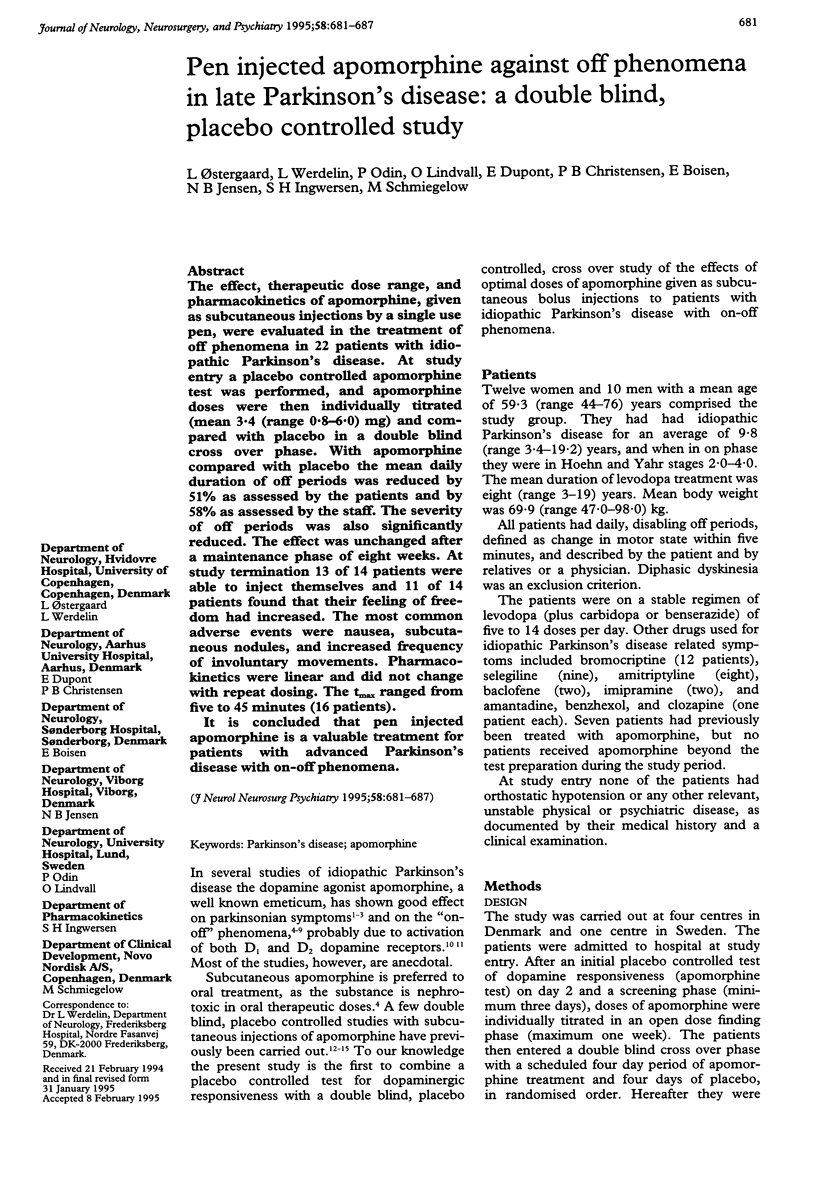
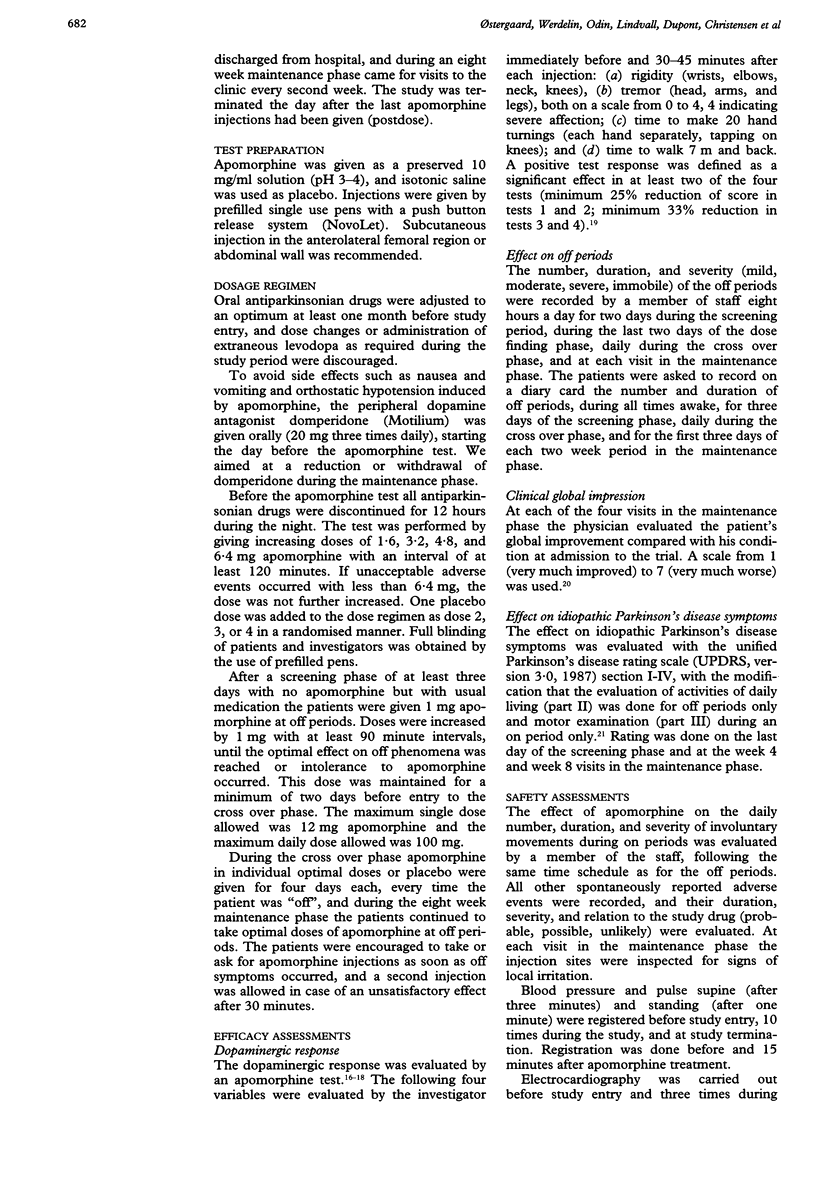
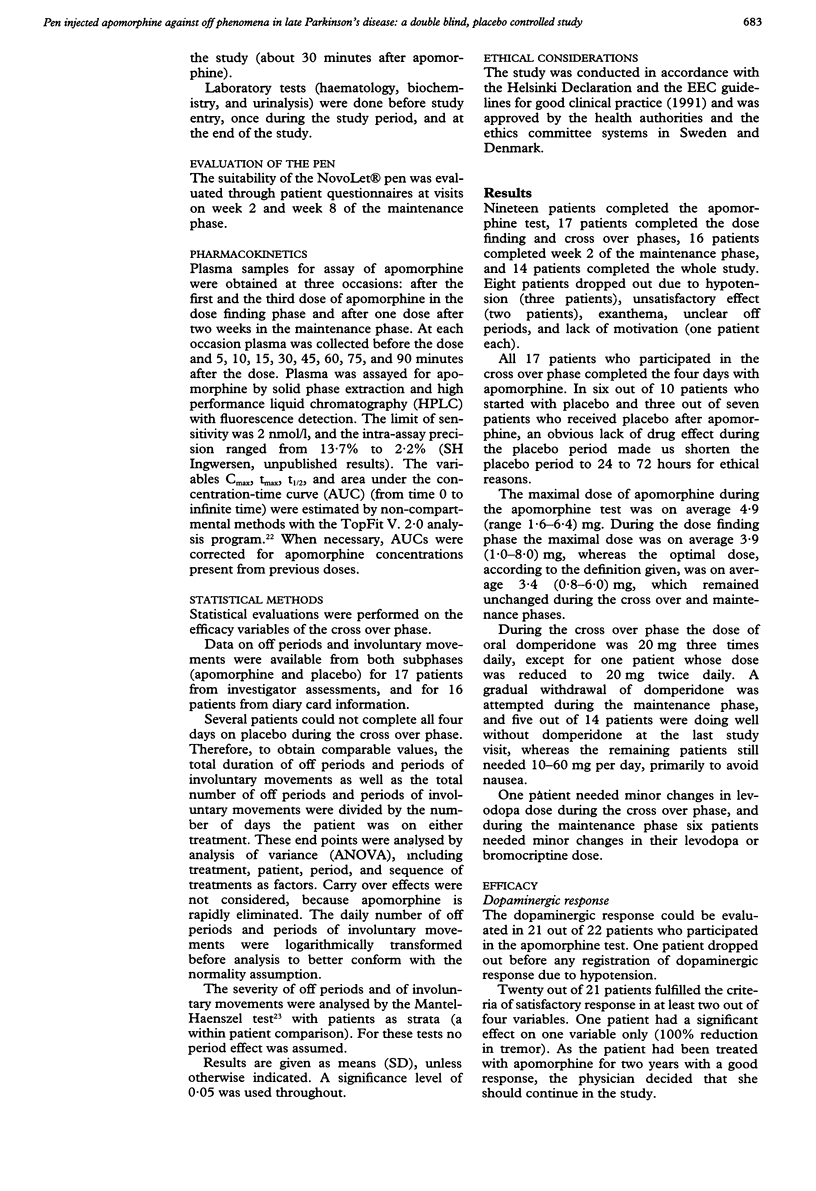
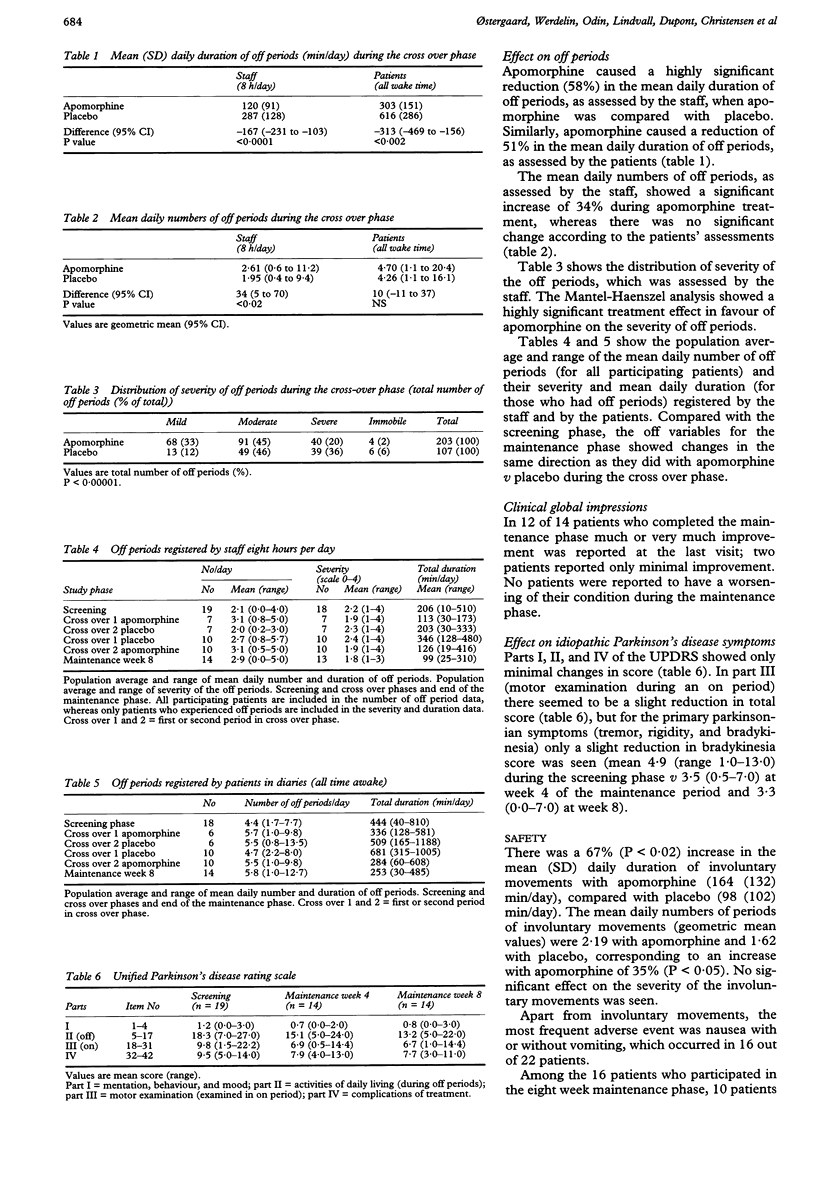
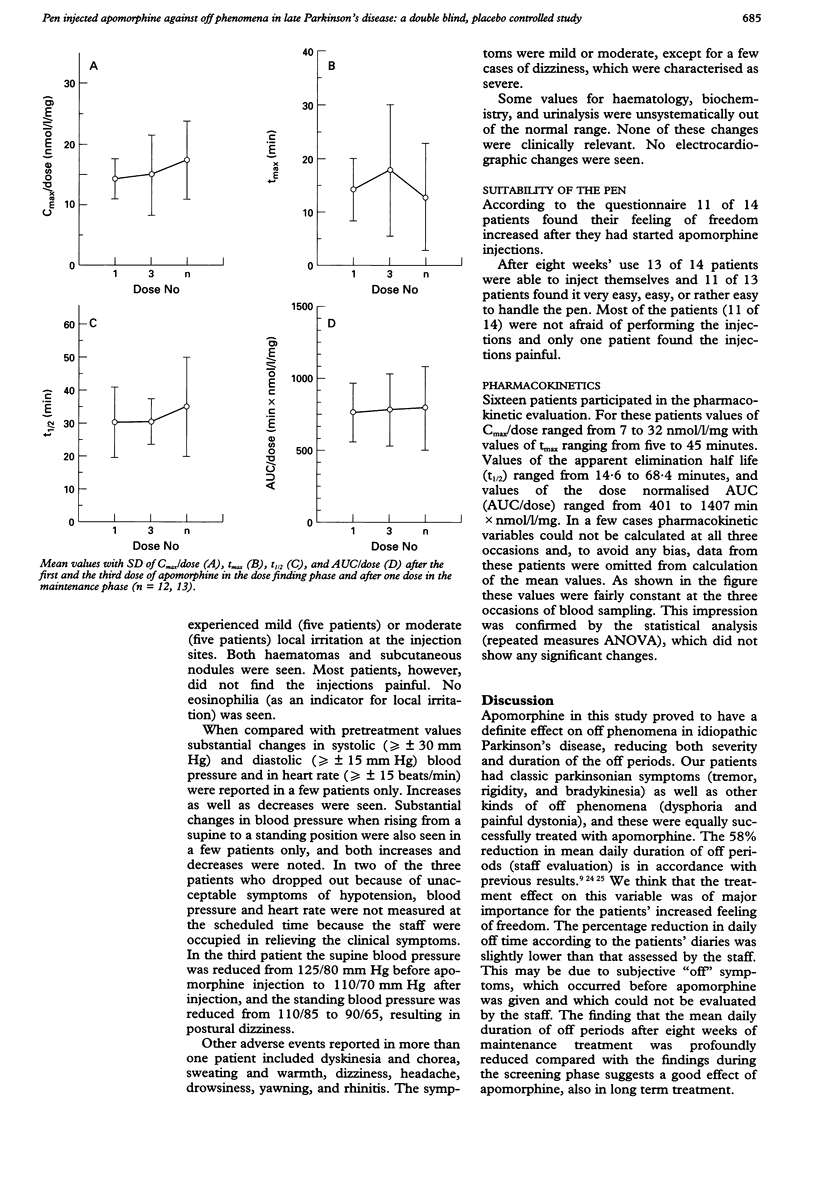
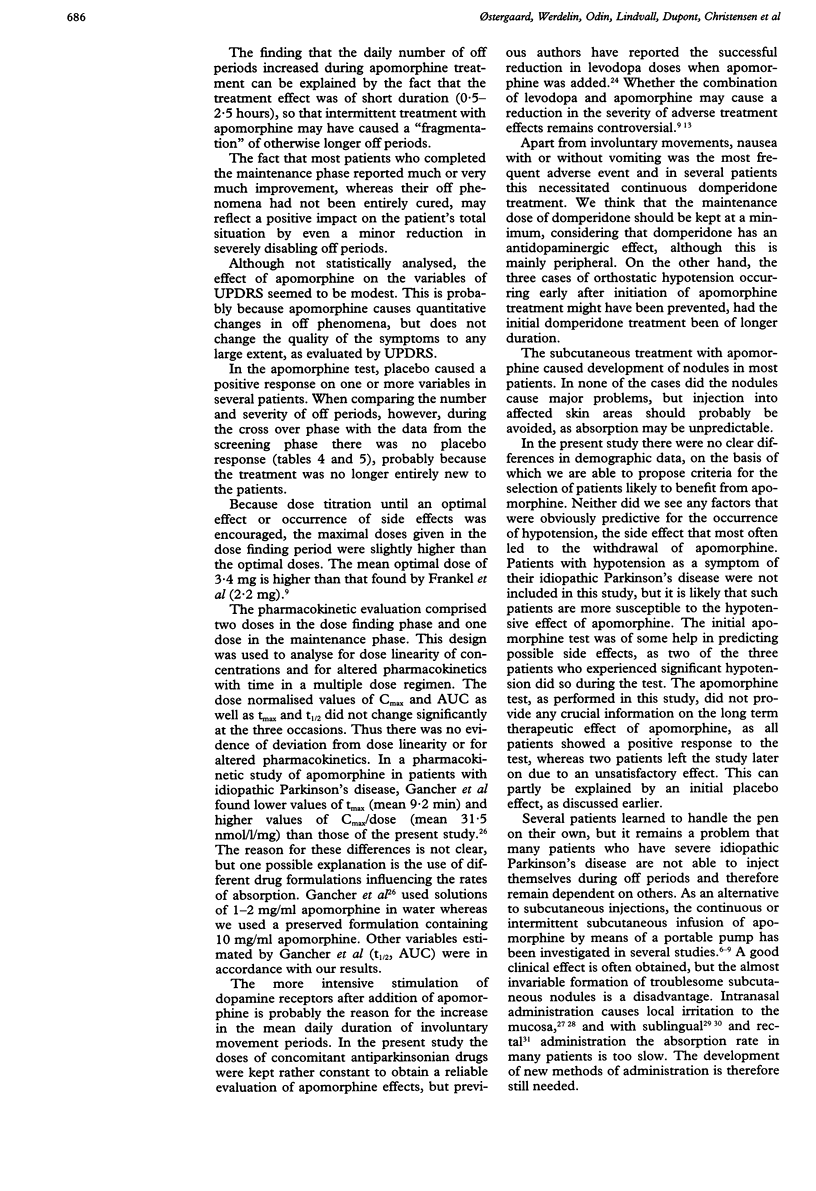
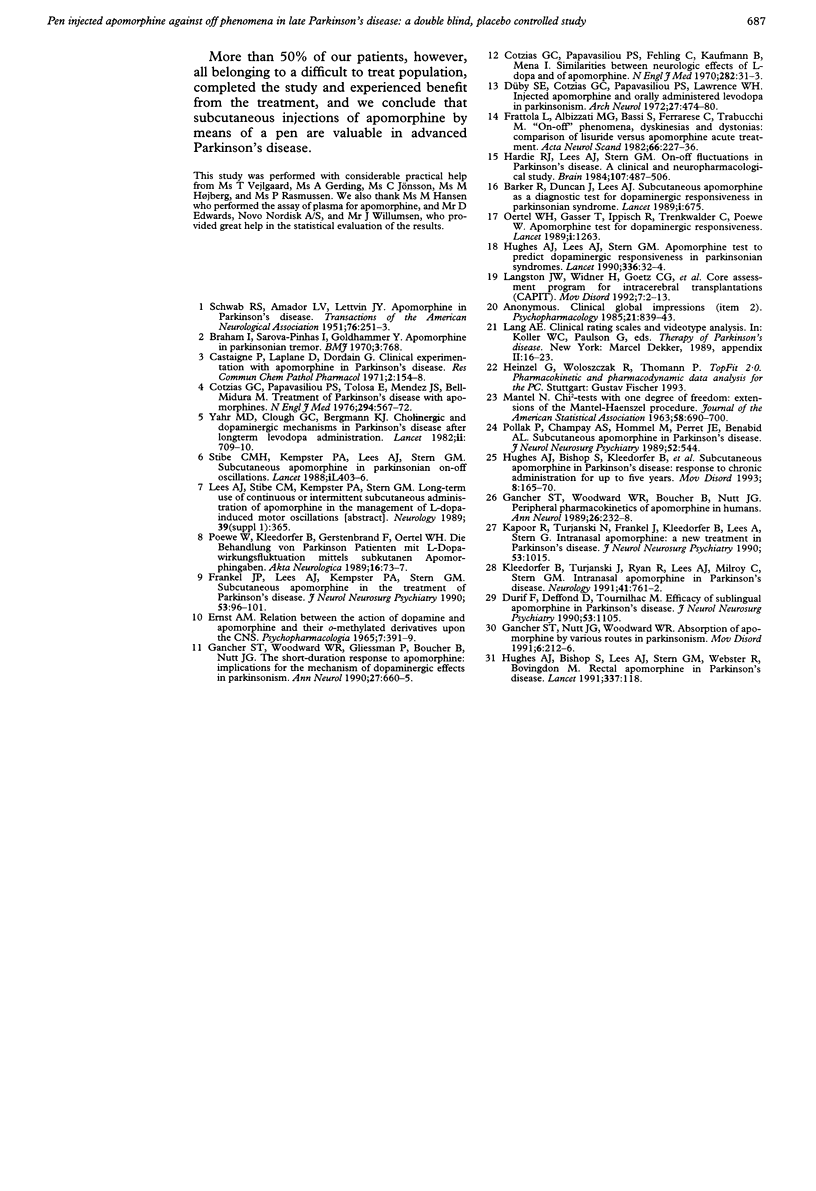
Selected References
These references are in PubMed. This may not be the complete list of references from this article.
- Barker R., Duncan J., Lees A. Subcutaneous apomorphine as a diagnostic test for dopaminergic responsiveness in parkinsonian syndromes. Lancet. 1989 Mar 25;1(8639):675–675. doi: 10.1016/s0140-6736(89)92183-1. [DOI] [PubMed] [Google Scholar]
- Braham J., Sarova-Pinhas I., Goldhammer Y. Apomorphine in Parkinsonian tremor. Br Med J. 1970 Sep 26;3(5725):768–768. doi: 10.1136/bmj.3.5725.768. [DOI] [PMC free article] [PubMed] [Google Scholar]
- Chanson P., Timsit J., Masquet C., Guillausseau P. J., Warnet A., Lubetzki J. Heart failure responding to octreotide in patient with acromegaly. Lancet. 1989 Jun 3;1(8649):1263–1264. doi: 10.1016/s0140-6736(89)92355-6. [DOI] [PubMed] [Google Scholar]
- Cotzias G. C., Papavasiliou P. S., Fehling C., Kaufman B., Mena I. Similarities between neurologic effects of L-dipa and of apomorphine. N Engl J Med. 1970 Jan 1;282(1):31–33. doi: 10.1056/NEJM197001012820107. [DOI] [PubMed] [Google Scholar]
- Cotzias G. C., Papavasiliou P. S., Tolosa E. S., Mendez J. S., Bell-Midura M. Treatment of Parkinson's disease with aporphines. Possible role of growth hormone. N Engl J Med. 1976 Mar 11;294(11):567–572. doi: 10.1056/NEJM197603112941101. [DOI] [PubMed] [Google Scholar]
- Durif F., Deffond D., Tournilhac M. Efficacy of sublingual apomorphine in Parkinson's disease. J Neurol Neurosurg Psychiatry. 1990 Dec;53(12):1105–1105. doi: 10.1136/jnnp.53.12.1105. [DOI] [PMC free article] [PubMed] [Google Scholar]
- Düby S. E., Cotzias G. C., Papavasiliou P. S., Lawrence W. H. Injected apomorphine and orally administered levodopa in Parkinsonism. Arch Neurol. 1972 Dec;27(6):474–480. doi: 10.1001/archneur.1972.00490180010004. [DOI] [PubMed] [Google Scholar]
- Ernst A. M. Relation between the action of dopamine and apomorphine and their O-methylated derivatives upon the CNS. Psychopharmacologia. 1965 May 21;7(6):391–399. doi: 10.1007/BF00402361. [DOI] [PubMed] [Google Scholar]
- Frankel J. P., Lees A. J., Kempster P. A., Stern G. M. Subcutaneous apomorphine in the treatment of Parkinson's disease. J Neurol Neurosurg Psychiatry. 1990 Feb;53(2):96–101. doi: 10.1136/jnnp.53.2.96. [DOI] [PMC free article] [PubMed] [Google Scholar]
- Frattola L., Albizzati M. G., Bassi S., Ferrarese C., Trabucchi M. "On-off" phenomena, dyskinesias and dystonias. Comparison of lisuride versus apomorphine acute treatment. Acta Neurol Scand. 1982 Aug;66(2):227–236. doi: 10.1111/j.1600-0404.1982.tb04520.x. [DOI] [PubMed] [Google Scholar]
- Gancher S. T., Woodward W. R., Boucher B., Nutt J. G. Peripheral pharmacokinetics of apomorphine in humans. Ann Neurol. 1989 Aug;26(2):232–238. doi: 10.1002/ana.410260209. [DOI] [PubMed] [Google Scholar]
- Gancher S. T., Woodward W. R., Gliessman P., Boucher B., Nutt J. G. The short-duration response to apomorphine: implications for the mechanism of dopaminergic effects in parkinsonism. Ann Neurol. 1990 Jun;27(6):660–665. doi: 10.1002/ana.410270613. [DOI] [PubMed] [Google Scholar]
- Hardie R. J., Lees A. J., Stern G. M. On-off fluctuations in Parkinson's disease. A clinical and neuropharmacological study. Brain. 1984 Jun;107(Pt 2):487–506. doi: 10.1093/brain/107.2.487. [DOI] [PubMed] [Google Scholar]
- Hughes A. J., Bishop S., Kleedorfer B., Turjanski N., Fernandez W., Lees A. J., Stern G. M. Subcutaneous apomorphine in Parkinson's disease: response to chronic administration for up to five years. Mov Disord. 1993 Apr;8(2):165–170. doi: 10.1002/mds.870080208. [DOI] [PubMed] [Google Scholar]
- Hughes A. J., Lees A. J., Stern G. M. Apomorphine test to predict dopaminergic responsiveness in parkinsonian syndromes. Lancet. 1990 Jul 7;336(8706):32–34. doi: 10.1016/0140-6736(90)91531-e. [DOI] [PubMed] [Google Scholar]
- Kapoor R., Turjanski N., Frankel J., Kleedorfer B., Lees A., Stern G., Bovingdon M., Webster R. Intranasal apomorphine: a new treatment in Parkinson's disease. J Neurol Neurosurg Psychiatry. 1990 Nov;53(11):1015–1015. doi: 10.1136/jnnp.53.11.1015. [DOI] [PMC free article] [PubMed] [Google Scholar]
- Kleedorfer B., Turjanski N., Ryan R., Lees A. J., Milroy C., Stern G. M. Intranasal apomorphine in Parkinson's disease. Neurology. 1991 May;41(5):761–762. doi: 10.1212/wnl.41.5.761-a. [DOI] [PubMed] [Google Scholar]
- Langston J. W., Widner H., Goetz C. G., Brooks D., Fahn S., Freeman T., Watts R. Core assessment program for intracerebral transplantations (CAPIT). Mov Disord. 1992;7(1):2–13. doi: 10.1002/mds.870070103. [DOI] [PubMed] [Google Scholar]
- Pollak P., Champay A. S., Hommel M., Perret J. E., Benabid A. L. Subcutaneous apomorphine in Parkinson's disease. J Neurol Neurosurg Psychiatry. 1989 Apr;52(4):544–544. doi: 10.1136/jnnp.52.4.544. [DOI] [PMC free article] [PubMed] [Google Scholar]
- SCHWAB R. S., AMADOR L. V., LETTVIN J. Y. Apomorphine in Parkinson's disease. Trans Am Neurol Assoc. 1951;56:251–253. [PubMed] [Google Scholar]
- Yahr M. D., Clough C. G., Bergmann K. J. Cholinergic and dopaminergic mechanisms in Parkinson's disease after long term levodopa administration. Lancet. 1982 Sep 25;2(8300):709–710. doi: 10.1016/s0140-6736(82)90728-0. [DOI] [PubMed] [Google Scholar]


